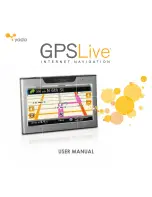
Localize
www.javad.com
126
Localization
The following portion of this manual was prepared by Shawn Billings,
PLS, dated June 25, 2014.
Localization
Localize within
J-Field
is capable of accomplishing two
unique tasks:
Determination of the position of the user’s base
station relative to a known control point or sample
of points surveyed by a Javad receiver in a known
coordinate system (such as State Plane, NAD83
latitude and longitude, etc).
Determination of a projection along with additional
rotation and scale, using survey observations made
by a Javad receiver to a sample of points in an
unknown coordinate system (such as from a total
station survey with an unknown or imprecise basis of
bearings).
Both tasks require careful selection of a suitable site for
the base station, open skies, away from trees, buildings,
structures such as overpasses and bridges, etc, within radio
range of the project site. Only “Fixed” solutions at the rover
should be used for survey grade results. Survey observation
points should be carefully selected also. Choose points
with open skies, away from trees, buildings, structures,
etc., that also provide precise centering. For localizations
to unknown coordinate systems, point geometry becomes
more critical as observations to these points will determine
scale and rotation of the resulting coordinate system. As in
total station surveying, ties to longer baselines with good
network distribution will give better results. Scrutinize
monuments to be surveyed to insure they appear stable
and unchanged since being established. Localizations are
a powerful tool, but must be handled with great attention
to detail for best results. Few other operations other than
localizations in GNSS surveying offer more potential for
gross errors.
Single Point Localization (Known)
Single Point Localization From Known Point In Known
Coordinate System
Goal
To determine the coordinates of the user’s base station
relative to a known point. This method would be useful for
surveys based on a geodetic monument in which the user
doesn’t want to directly occupy the monument with the
base station.
What you need
1. Known Coordinates of a point in a Known Coordinate
System. The Known Point should be within radio range
of the base. The Known Point should be in open sky
and be in good condition since being established
2. Accurate survey tie to point from base station. Use only
fixed ambiguity solutions with careful centering and
plumbing of the rover pole.
Содержание TRIUMPH-LS
Страница 1: ...U S E R S G U I D E TO T H E T R I U M P H L S E Version 20160121 ...
Страница 17: ...www javad com 17 Introduction ...
Страница 39: ...www javad com 39 Collect Screens ...
Страница 59: ...www javad com 59 Stake Out Points ...
Страница 91: ...www javad com 91 Stake Out Alignments ...
Страница 93: ...www javad com 93 Using ShapeTags and Codes Data Structure ...
Страница 105: ...www javad com 105 Using ShapeTags and Codes ...
Страница 149: ...www javad com 149 Localization ...
Страница 165: ...www javad com 165 Appendix B NGS AntCal Appendix B NGS AntCal Data http www ngs noaa gov ANTCAL Antennas jsp manu Javad ...
Страница 166: ...www javad com 166 Appendix B NGS AntCal Appendix B NGS AntCal Data http www ngs noaa gov ANTCAL ...
















































